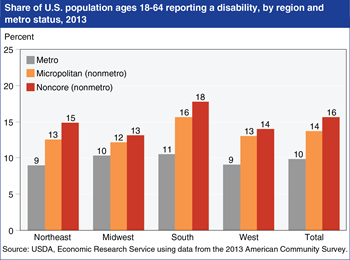Dec
06

Posted by Margot M on December 6th, 2019
Posted in: Public Health
Tags: rural health, Training, transportation
On Nov 14, 2019, the United States Department of Agriculture (USDA) released the annual “Rural America at a Glance” report. The USDA’s Economic Research Service (ERS) issues this 6-page report. The ERS studies Rural Poverty and Well-being with a focus on the economic, social, spatial, temporal and demographic factors that affect the poverty status of rural residents.
 In 2018, the ERS looked at the intersection of race/ethnicity and rural poverty. This year’s report looks at the intersection of disability and rural poverty. While employment is growing nationwide, there are low labor force participation rates in isolated rural counties. The population in these counties are older, less educated and are more likely to be disabled. This graph shows the distinct differences of disability in urban (metro) areas and rural areas.
In 2018, the ERS looked at the intersection of race/ethnicity and rural poverty. This year’s report looks at the intersection of disability and rural poverty. While employment is growing nationwide, there are low labor force participation rates in isolated rural counties. The population in these counties are older, less educated and are more likely to be disabled. This graph shows the distinct differences of disability in urban (metro) areas and rural areas.
According to ERS definitions, micropolitan counties are rural areas located near urban clusters of 10,000-49,999 persons. Noncore counties are more isolated and do not enjoy the benefits of nearby urban communities.
The 2013 American Community Survey estimated that 15.1% of the rural population have disabilities. As a result, these rural residents may not have adequate, reliable transportation. Not only does this impact employment and educational opportunities, but also access to specialized healthcare.
In a recent NNLM webinar, participants identified transportation as impacting health outcomes above lack of broadband, insurance and providers. If transportation is a concern in your area, please see the Rural Health Information Hub’s Transportation to Support Rural Health Care topic guide.
This guide includes information such as:
On National Rural Health Day, we hosted a webinar entitled “From the Mountains to the Sea: Rural Health Issues and Resources.” Anyone interested in this topic may watch the recording and contact me for the assignment. Please email margot.malachowski@umassmed.edu. NOTE: there is a 10-second delay in the audio for this recording.
The assignment is due on January 7, 2020.